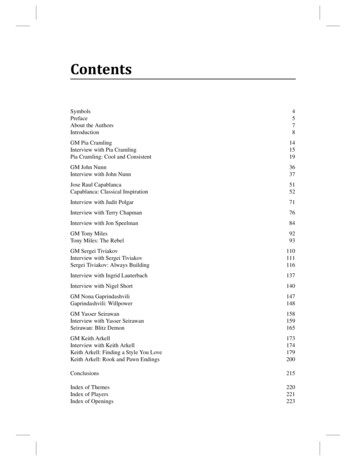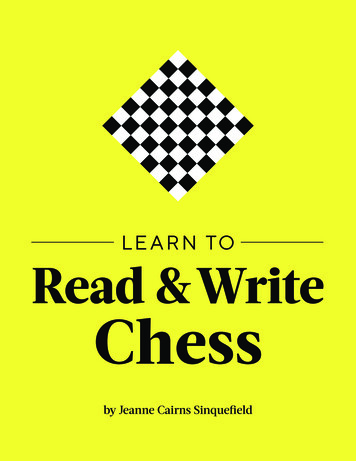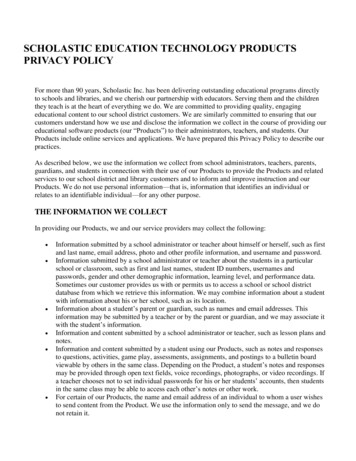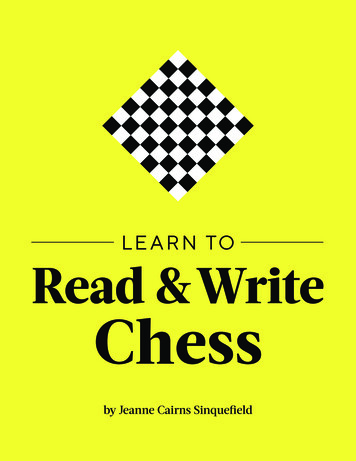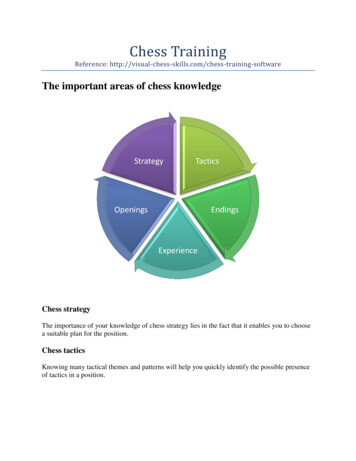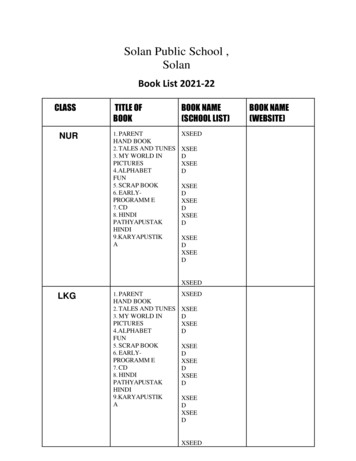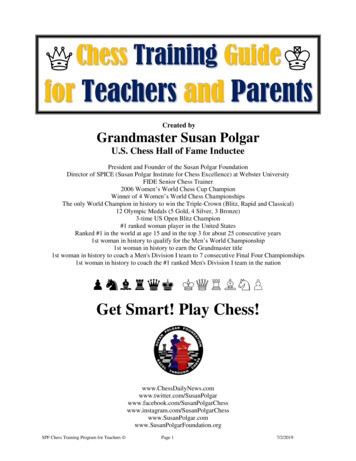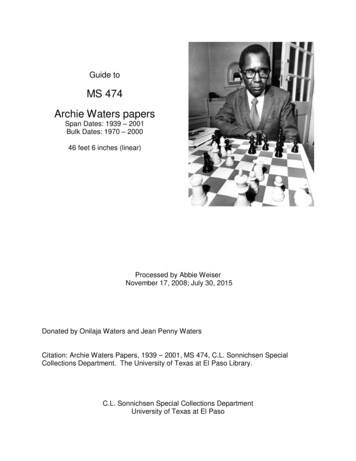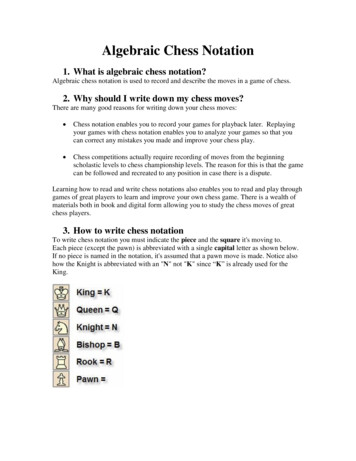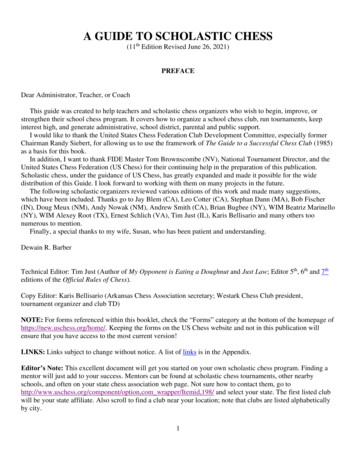
Transcription
A GUIDE TO SCHOLASTIC CHESS(11th Edition Revised June 26, 2021)PREFACEDear Administrator, Teacher, or CoachThis guide was created to help teachers and scholastic chess organizers who wish to begin, improve, orstrengthen their school chess program. It covers how to organize a school chess club, run tournaments, keepinterest high, and generate administrative, school district, parental and public support.I would like to thank the United States Chess Federation Club Development Committee, especially formerChairman Randy Siebert, for allowing us to use the framework of The Guide to a Successful Chess Club (1985)as a basis for this book.In addition, I want to thank FIDE Master Tom Brownscombe (NV), National Tournament Director, and theUnited States Chess Federation (US Chess) for their continuing help in the preparation of this publication.Scholastic chess, under the guidance of US Chess, has greatly expanded and made it possible for the widedistribution of this Guide. I look forward to working with them on many projects in the future.The following scholastic organizers reviewed various editions of this work and made many suggestions,which have been included. Thanks go to Jay Blem (CA), Leo Cotter (CA), Stephan Dann (MA), Bob Fischer(IN), Doug Meux (NM), Andy Nowak (NM), Andrew Smith (CA), Brian Bugbee (NY), WIM Beatriz Marinello(NY), WIM Alexey Root (TX), Ernest Schlich (VA), Tim Just (IL), Karis Bellisario and many others toonumerous to mention.Finally, a special thanks to my wife, Susan, who has been patient and understanding.Dewain R. BarberTechnical Editor: Tim Just (Author of My Opponent is Eating a Doughnut and Just Law; Editor 5th, 6th and 7theditions of the Official Rules of Chess).Copy Editor: Karis Bellisario (Arkansas Chess Association secretary; Westark Chess Club president,tournament organizer and club TD)NOTE: For forms referenced within this booklet, check the “Forms” category at the bottom of the homepage ofhttps://new.uschess.org/home/. Keeping the forms on the US Chess website and not in this publication willensure that you have access to the most current version!LINKS: Links subject to change without notice. A list of links is in the Appendix.Editor’s Note: This excellent document will get you started on your own scholastic chess program. Finding amentor will just add to your success. Mentors can be found at scholastic chess tournaments, other nearbyschools, and often on your state chess association web page. Not sure how to contact them, go tohttp://www.uschess.org/component/option,com wrapper/Itemid,198/ and select your state. The first listed clubwill be your state affiliate. Also scroll to find a club near your location; note that clubs are listed alphabeticallyby city.1
This publication is provided FREE to all schools and scholastic organizers. It is not to be soldfor profit.Contents copyright 1986, 1990, 1992, 1994, 1995, 1997, 1998, 2001, 2003, 2009, 2017, 2019,2021 American Chess Equipment, 444 E. Gardena Blvd, Building AGardena, CA. 90248Phone: 310-329-9143 Ext. 222Republication or widespread copying of all other portions of this publication without the writtenconsent of American Chess Equipment is forbidden.EDITOR IN CHIEFShelby LohrmanAmerican Chess Equipment, Inc.amchesseq.comPRODUCTION STAFFShelby Lohrman, Dewain Barber, Jay Stallings, Dan Lucas (US Chess), and Ernie Schlich.Technical Editor, Tim JustCopy Editor: Karis BellisarioThis publication is produced with the assistance of the U.S. Chess Federation, a non-profit501(c) (3).2
CONTENTSI. WHAT IS A SCHOOL CHESS CLUB? . 5Chess Clubs and Chess Players. 5Should I Start a Scholastic Chess Club? . 5II. GETTING READY TO START A CHESS CLUB . 7Who? What? When and How Often? Where? Why? How? . 7III. GETTING OFF TO A GOOD START . 10The First Few Meetings . 10Equipment & Supplies . 10Publicity . 14Club Officers and Aides. 15IV. KEEPING THE CLUB GOING . 19Building a Base: The First Few Months . 19News Releases . 19Club Newsletter . 21Instruction . 22Lesson Plan Ideas . 23Summer Chess Camps . 24Online Play. 24Community Clubs . 24Club Ladder . 24Club Ratings. 25Harkness System . 26Other Ways to mix-it-up, and Keep Things Fresh: . 26V. YOUR CLUB AS A TOURNAMENT SPONSOR . 30Tournament Format? . 30The Club Tournament . 31The Weekend Scholastic Tournament . 32VI. CLUB FINANCES . 37Funding . 37Banking . 37Insurance . 38Taxes . 38VII. LARGER CHESS ORGANIZATIONS . 39Benefits of State Association . 39US Chess Club Affiliation . 39US Chess-Rated Tournaments . 40US Chess Certified Chess Coach Program . 40VIII. NATIONAL PROGRAMS . 42IX. APPENDIX. 44Suggested Books for Scholastic Chess . 453
Chess Books Recommended for Parents, Teachers & Coaches . 46Useful Software/Internet Information for Teachers, Coaches, and Students . 46Types of Tournaments . 47Tournament Planning Sheet . 52Tournament Supplies . 53Sample Flyer . 54Tournament Accounting Sheet . 55Tournament Financial Summary. 56Travel Permission Form . 57An Abridged List of 21 Successful Rulebook Player Habits . 59Chess Algebraic Notation . 61Club Ladder . 64Contact Card . 65Internet Links . 66Quad Pairing Chart . 67A Glossary Of Terms . 68INDEX . 734
I. WHAT IS A SCHOOL CHESS CLUB?Chess Clubs and Chess PlayersThe scholastic chess club combines educational and social activities. Members come to play,learn, teach, and to get together with old friends and make new ones. The players—no matterwhat their level of skill, experience, or age— speak a common language, and one that is oftennot understood in other areas of a person’s life. The rivalries are friendly; the friendships arecompetitive. A club can offer a wide variety of activities. There can be speed chess or ratedgames, or both. Club activities can include simultaneous exhibitions, lectures, and even formalclasses taught by Chess Masters, Experts or other experienced players. Some players whoregularly come to a club won’t ever try weekend scholastic tournaments. These avid club playersmay get their fill of “serious” chess by competing in a club ladder or one game per lunch periodclub tournaments. Ideally, the club will cater to all types of players—recreational players as wellas the serious tournament players. EVERY member is important to the success of the club.Evidence shows that player’s benefits include improvement in literary, math, critical thinkingand life skills—including sustained focus, conflict resolution, respect, and more.Should I Start a Scholastic Chess Club?Should you become involved in starting a club in your school? Yes! It’s not at all necessaryfor you to be an “expert” player, or even to know how the pieces move!Every school in the country has kids likely to have had some exposure to chess from familyplus more who would like to learn. “No one at our school plays chess” is not an acceptableexcuse. Most of the time kids are interested in learning and only need someone to organize andsupervise them.This guidebook offers the resources and assistance needed in meeting the possible obstaclesyou might face in starting a club. Along the way you will find that many of your questions willbe answered. If you have not already done so, you may want to find out the location of thenearest chess club or scholastic/school club. The United States Chess Federation (abbreviated USChess) and your state chapter is the best sources of information on officially affiliated clublocations, scholastic organizers and coaches in your area. Find affiliate clubs, organized by state,here: http://www.uschess.org/component/option,com wrapper/Itemid,198/These contacts can help direct you further in your efforts to organize a club or locate otheractive scholastic chess programs within your area. Other information sources include localschools, school district offices, newspapers, libraries, chess and game stores, on-line chess stores,your local recreation office, plus Boys and Girls clubs or scout troop leaders. You might alsoconsider contacting your local or state Department of Education.5
By all means, you should start a club if you have some support from students and thewillingness to expend the moderate amount of energy and leadership it will take to make yourclub a success. Gain support from the school board, parents, your principal, and other teachers assoon as possible. Their aid will be useful later as the club becomes more active.The fact that the National Association of Secondary School Principals regularly includes theNational High School Chess Championship and the National Scholastic K-12 Grade ChessChampionships on its “National Advisory List of Contests and Activities” may be of value ingaining official support for your club. Learn more about these, and other, National events here:http://www.uschess.org/content/view/10015/956
II. GETTING READY TO START A CHESS CLUBWho? What? When and How Often? Where? Why? How?Reporters know that their stories should answer the basic questions—Who? What? When?Where? Why? and How? These are the right questions for other projects too—including schoolchess clubs.Who?Hopefully you are probably not alone in your interest—yet you may have been assigned to thechess club. Fear not, we are here to help you. Finding a couple of students is all it takes to start asuccessful school club. Together you can attract other students. Consider involving youngsters atyour school who are in special programs—people with learning, developmental, or physicalchallenges, as well as the gifted. Personal growth has no limit. Your school administration willbe pleased to see these youngsters taking an active role in your school sponsored activity. Avoidstereotyping who would be interested in chess. We have seen school programs where the topplayer is also one of the top athletes, or top academic students, as well as the struggling studentwho benefits from finding his/her niche.As noted in “Chess Clubs and Chess Players” (see page 5) the school chess club is both aneducational and social activity. It provides those who know how to play and those interested inlearning the game a place to meet, play, learn, teach, and develop friendships. However, a clubshould not be a place to “hang out,” “kill time,” or avoid academic work. The chess club at aschool can and should be fun, but it is a learning experience above all else.What?Your students, and your enthusiasm, will draw in others. Students or community volunteerscan assist you in deciding what kinds of activities you should have, but it will be useful for youto have a plan for the first several meetings.The folks at Chess Kid have designed an extensive chess curriculum that any teacher can use,even those unfamiliar with chess. It meets the learning objectives that will please administratorsand parents alike. It is nicely organized and laid out. The lessons are incremental, and as long asyou are a couple lessons ahead of the students, you will be able to share the informationeffectively. You can find your free copy dcoms-curriculum. For those who prefer a simpleover view of lessons plans, without the details of a curriculum, will find this at-a-glance topic listhelpful: https://www.chessmagnetschool.com/lesson guide.phpAlso, set goals with your students; decide what you and the players wish to accomplish by theend of the first three months. Before announcing the get-acquainted organizational meeting in thestudent bulletin and posted fliers, plan a specific agenda. Don’t forget to play some chess too!Most students attracted to chess have a need for structure and rules. Experiment with variousactivities to determine what is successful in your club.7
When and How Often?The answer(s) to this apparently simple question can have a major effect on the success ofyour school club. Some school clubs have the question answered by outside forces, such asclassroom or library availability. If early busses are available, your club may be able to meetbefore school. Otherwise, after school may be better, though some students have after-schooljobs, chores or competing extra-curricular activities and may not be able to attend in theafternoon. Keep in mind the other activities of your potential members, as well as the school busschedule, when planning your meeting time.You might be surprised to learn that lunch period is a good time for a meeting. Theadministration will appreciate seeing students using their lunch period in a supervised,productive manner. And because students can bring a sack lunch with them, they can have moretime to play. One committed chess teacher used a special lanyard that allowed the chess studentsto receive their lunch trays from the cafeteria first, and they brought their trays to the meetingroom. While they ate lunch, she did the chess lesson, and then after stacking their trays, theywere ready for playing. In any case, you probably want to allow at least 30 minutes at lunch for aclub session, or up to one hour after school. Meet at least once a week (or daily if your schedulepermits).Where?Find a room with chairs and tables. Your classroom may be big enough for your firstorganizational meeting and may become the club’s permanent meeting place. If the room is notsuitable, see if the library is available at the time your club meets. For example, the library maybe busy with other students during lunch, so check things out. Keep storage needs in mind as youscout for a site at the school. You’ll need a place to keep equipment, tournament stationery, clubrecords, and so forth. A secure closet or the possibility of a locked cabinet is a definiteadvantage, but you can start simply with a plastic tub that holds your pieces in zip lock bags(quart size for each color set, with the two quart bags together in one gallon bag) and a small,clean plastic wastebasket is ideal for storing a dozen rolled boards.8
Why?One of your reasons for starting a chess club is to have a place for students to play chess or tocreate an alternative to the existing activities at school. In addition, you recognize the educationalvalue (critical and abstract thinking, planning, logic, analysis, even enhanced literary and mathskill connections) that comes from chess. Your students will improve their ability to concentrate,and you, through chess, can teach the value of good sportsmanship, respect, and stressmanagement. Studies have also shown that chess can help kids improve their school grades.Whatever other reason there may be for a club, the excitement in the eyes of your students whenthey win their first game or team match may be reason enough.How?Most of the rest of this book is devoted to how to do things in a chess club. The best way todescribe the non-technical side of “how” is “friendly.” Treat your club members as you wouldguests in your home. Greet them; introduce them around; make sure they feel that this is theirclub too. One concrete way to get off to a good start with a newcomer is to make sure you havesome extra sets and boards handy. That way, no visitor will be disappointed. Almost any set willdo, but consider standardizing as soon as possible. Other very important parts of “how” are clubstructure and funding. These areas are so important that they are treated in separate sectionselsewhere in this publication. You’re now ready to get started with your club. It may require a bitof work, but it will be well worth the effort!9
III. GETTING OFF TO A GOOD STARTThe First Few MeetingsEveryone is nervous at the beginning of something, and your new “members” are apt to be asapprehensive as you are! Be as friendly and relaxed as you can. Prepare a single page handout ofclub guidelines that states the club’s goals in advance of the first meeting. It may be too early toelect officers, but not too early to instill the idea that there should be a division of authority.Next, be sure to get some basic information about everyone—name, grade, phone number, email, and chess experience. See the contact card in the Appendix. You may want participants tofill out a simple survey, a membership form, or a commitment form (see Glossary) within thefirst couple of weeks. For the first time or two, it’s probably enough to pair up people randomly.If you’re playing, you might want to abandon your seat and game to make room for the nextstudent who walks in the door. You may have some experienced players who want to get seriousright away. Don’t keep them waiting too many weeks! As soon as possible, determine if you willneed two or more groups (Division A, Division B, Division C, etc.). Your top division will becomposed of those players with some tournament experience or those who have played in theclub at school last year. You might have to keep everyone together if you lack enoughexperienced players to form a Division A. You might prefer to name your groups something likeKnights, Bishops, Pawns, etc. Avoid the temptation to group the students by grade, instead groupthem by skill/experience.Once you have covered the basics of how the pieces move, and rules of play, one of the bestearly activities is a round-robin tournament, in which everyone plays each other. (Form isavailable at Form.pdf) This might alsohelp you identify student’s skills more easily to make appropriate placement in later divisions.You might give this event an interesting name like Pawn Pushers Special. Division or sectionsizes should be from 8 to 12 players. (If the size of the division is in excess of 12, the tournamenttakes too long to finish. You want the tournament to last about three weeks.) After all players ineach section play each other to determine the best two or three players in each section, you canorganize the next tournament (the Bishop’s Bash), in which you’ll pair in Division A the topthree from each section of the previous tournament. As you find new students, simply add to thebottom division and allow them to work their way up. If by chance you encounter a new studentat mid-year who already has some experience, you may wish to insert him or her directly into theappropriate section. Sometimes students will arrive who tell you they know how to play, butupon further evaluation, you discover that some foundational information is unknown—maybeen passant or castling for example.Equipment & SuppliesMost clubs will provide equipment for members. Club-owned equipment makes the clubseem more “real”, and it can lend a desirable sense of uniformity and unity to the chess activities.If you haven’t done so already, now is the time to contact US Chess for a “scholastic packet.”It’s free, and it contains helpful information on scholastic chess. Right from the start, there are afew inexpensive items that are virtually essential:10
Chess PiecesGo for a standard size (3½’’ to 4” King), solid plastic set in the traditional Staunton design.For this purpose the “Club Special” set fits the bill. Stay away from cheap, hollow plastic piecesif possible—they tend to break and are simply less pleasant to handle than solid plastic pieces.Kids can sometimes be rough on equipment, so it’s important to have sets which are as “kidproof” as possible. While pricier, silicon pieces are virtually indestructible. A onetimeinvestment will last for years as these do not chip or break even if dropped onto tile floors. Theage of your students, and the flooring in the room you are using might also be a factor in yourchoice, as well as budget. You can further protect chess pieces by placing them in a wood box orvinyl or plastic bag. Perhaps your school’s home economics class can prepare cloth bags withdrawstrings or the shop class can make wooden boxes.Chess BoardsUse boards proportioned to your pieces—or get tournament-sized boards (2’’ to 2 1/4’’squares). Cardboard boards may wear out too fast. Vinyl roll-up boards are excellent. Be sure toget the ones with the algebraic notation (letters and numbers) on the sides so you can teachnotation faster to your students. If student desks are too small for the vinyl roll-up board, youwill want to use rigid material under the roll-up board so that it can be placed on the desk orreduce the size of the board from a 20” (2 1/4” squares) to a 17” (1 7/8” squares). If there is anexperienced chess teacher available or a large number of students who wish to learn, ademonstration board or a computer hooked up to a digital projector is very handy. If you wish topurchase a demonstration chessboard for your classroom, check with U.S. Chess or AmericanChess Equipment, Inc. A slotted or magnetic style demonstration board may also be available soyou can show moves and puzzles to a large group easily. And don’t forget there are computerprograms that can be projected onto a screen that work also work well; however, that method canbe expensive.Score SheetsMany club players like to keep a record of their games. You will, of course, have to teachyour students how to take notation, but after one lesson they will probably be ready to use anyscore sheet or scorebook that is available. You can make your own. US Chess or AmericanChess Equipment, Inc. are also inexpensive and reliable sources. From this bare minimum, thesky’s the limit on equipment and supplies. Your particular needs will determine exactly what youshould get—and what kind of revenue or school funding program you will need to develop.Perhaps you can find a local business or PTA that will support chess in your school.ScorebooksA scorebook is absolutely essential for any serious player of the game. A paper scorebook is avery inexpensive way to keep a record of all of your games in one place. You should encourageeach of your students to purchase one. A paper scorebook should contain at least one diagram onthe back of each page for adjournments, with ample space for notes. It’s also helpful to keep onhand some blank diagrams, in case the bell rings during the chess period. Then, the students canquickly record the position of a game and be able to resume it the next day or the next time theclub meets. Another option is to snap a quick photo of the board position before putting thepieces away. The photo will allow you to reset the board and resume play where you left off.Some players have difficulty writing chess notation. Electronic score keeping devices are11
expensive but have a graphical input that students may find easier. The only US Chessauthorized electronic score keeping devices are: Monroi (http://monroi.com/), E-Notate (nolonger available), and PlyCounter (no longer available). Learning notation is important however,as it is the language of chess spoken in chess puzzles, books, online apps, chess magazines, atcommunity clubs, etc.NotebookSize and style don’t matter much, but you need some place to write down various notes. It’san excellent idea to keep a written record of all club proceedings, because it’s easy to forgetthings later. Some people prefer to dispense with hand written notes and keep their records on acomputer. Either way works.Computer InformationYou can keep the club roster on your computer. Computers also give you plenty of room forexpanding information about your students—like all-important telephone numbers and e-mailaddresses. (Phone numbers and e-mail addresses must remain confidential).SoftwareThere are two types of software that you may wish to acquire: management software andinstructional software. A good software package is a valuable tool that can help you run yourchess club more effectively. A complete software package includes templates for a variety offorms and certificates that you will wish to use. Your management software can also help youestablish a club rating system.Interactive instructional software is an excellent teaching tool that allows kids to learn at theirown pace. Your students may resist suggestions to read chess books, but they will jump at theopportunity to use instructional software! ChessKid Gold is not free but it is a deeply discountedservice for schools. The Gold membership with ChessKid (fees may apply) opens up a vast arrayof learning tools: 600 videos, lessons, 50,000 tactics puzzles, numerous articles and more, all ina kid-friendly, safe online program. You, as the teacher/coach, receive a free ChessKid Goldmembership so you can see what your students are doing, which lessons they have watched,puzzles completed
Chairman Randy Siebert, for allowing us to use the framework of The Guide to a Successful Chess Club (1985) as a basis for this book. In addition, I want to thank FIDE Master Tom Brownscombe (NV), National Tournament Director, and the United States Chess Federation (US Chess) for their continuing help in the preparation of this publication.
